This article needs additional citations for verification .(January 2022) |
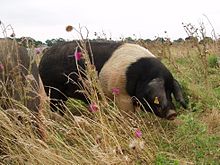 An Essex boar | |
| Country of origin | United Kingdom |
|---|---|
| Traits | |
| |
The Essex is a breed of domestic pig originating in the United Kingdom.
This article needs additional citations for verification .(January 2022) |
 An Essex boar | |
| Country of origin | United Kingdom |
|---|---|
| Traits | |
| |
The Essex is a breed of domestic pig originating in the United Kingdom.
The Essex, in its traditional form, was a smallish pig with 'pricked' ears and a black ground colour, with a broad band of white 'sheeting' across the shoulders.

Like other old British pig breeds, the ancestor of the Essex may have originated in the county of the same name from selective breeding of local wild pigs.[ citation needed ] It was originally a smallish, "coarse" black-and-white pig that was noted for being easy to keep and cheap to feed, qualities that ensured its popularity with smallholders. The Old Essex, as it came to be known, was deliberately "improved" in the mid 19th century by crossing it with imported pigs. [1] In the early nineteenth century, while travelling in Italy, Charles Western, 1st Baron Western obtained Neapolitan pigs to cross with his Essex sows. One of his tenants, Fisher Hobbs, bred the resulting Neapolitan-Essex boars with his "coarse" Essex sows and established the Improved Essex. In 1840 an Improved Essex boar and sow, both bred by Hobbs, each took first prize in its class at the second show of the Royal Agricultural Society at Cambridge. [2]
The Essex pig remained locally popular until as recently as the mid-1950s, and had actually increased in numbers during the Second World War and immediately afterwards, based on its reputation for hardiness and its ability to feed itself by foraging. [3] In 1954, 488 Essex boars (2% of the total British stock) were still licensed, and 3,716 sows registered. [3]
The position of the Essex breed changed markedly after the publication of a 1955 report by the Advisory Committee on the Development of Pig Production in the United Kingdom, chaired by Sir Harold Howitt. [4] The report, issued after the end of wartime rationing, expressed concern that the UK's pig farms were poorly placed to compete with European and Scandinavian pork and bacon producers, particularly those of Denmark, and identified that the wide variety of local breeds still used in the UK hampered development. It was therefore recommended that pig farmers concentrate on three breeds: the Welsh, the Landrace, and the Large White, and as a result the Essex pig went into a steep decline.
While the breed societies of the Wessex (another breed featuring a black ground colour and white shoulder markings, although with a different origin) and Essex pigs had amalgamated as early as 1918, the formal end of the Essex pig came in 1967, when the stud books were also amalgamated with the intention of merging the two breeds into the British Saddleback. This was intended to improve the breed's characteristics, produce hybrid vigour, and prevent inbreeding in the remaining small herds. For many years the Essex pig was considered to have become extinct in 1967, although it was thought a few pure-bred individuals might survive on small farms.
Later research showed that one farmer, John Croshaw, had refused to amalgamate his herd of Essex pigs (the "Glascote Herd"), which retained a pure Essex bloodline despite being officially registered as British Saddlebacks: Croshaw had carefully managed his stock to avoid inbreeding. [5]

The Tamworth, also known as Sandy Back and Tam, is a breed of domestic pig originating in its namesake Tamworth, Staffordshire United Kingdom. It is among the oldest of pig breeds, but as with many older breeds of livestock, it is not well suited to modern production methods and is listed as "threatened" in the United States and "vulnerable" in the UK by the Rare Breeds Survival Trust, as fewer than 300 registered breeding females remain. This animal is of ginger to red colouration and is thought to have descended from wild boars, via native pig stock of Europe. Principal populations today are in the United Kingdom, Australia, the United States, New Zealand, and Canada.

The Angeln Saddleback, also known as the Angler Sattelschwein, is a rare breed of domestic pig grown mainly in Schleswig-Holstein, Germany. It is a large, lop-eared, black pig with a white belt around its body at the forefeet.

The Berkshire is a British breed of pig. It originated in the English county of Berkshire, for which it is named. It is normally black, with some white on the snout, on the lower legs, and on the tip of the tail.
The Semirechensk is a Kazakh breed of domestic pig. It was purpose-bred in the twentieth century in the Kazakh Soviet Socialist Republic of the Soviet Union. The breeding stock was principally Large White, with some admixture of Siberian Kemerovo and a small proportion of wild boar.
The Aksai Black Pied is a distinctively black and white spotted pig breed from Kazakhstan.

The Poland China is an American breed of domestic pig. It was first bred in Warren County in Ohio, in the American Midwest. Its origins lie in a small number of pigs of Chinese type bought in 1816, which were cross-bred with a variety of breeds of European origin including the Berkshire. It was bred as a lard pig, and is among the largest of all pig breeds.

The Wessex Saddleback or Wessex Pig is a breed of domestic pig originating in the West Country of England, (Wessex), especially in Wiltshire and the New Forest area of Hampshire. It is black, with white forequarters. In Britain it was amalgamated with the Essex pig to form the British Saddleback, and it is extinct as a separate breed in Britain. However, the Wessex Saddleback survives in Australia and New Zealand.
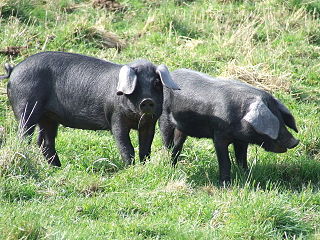
The Large Black pig is a British breed of domestic pig. It is the only British pig that is entirely black. It was created in the last years of the nineteenth century by merging the black pig populations of Devon and Cornwall in the south-west with those of Essex, Suffolk and Kent in the south-east. It is hardy, docile and prolific; it forages well and is suitable for extensive farming, but not well suited to intensive management.

The Mangalica is a Hungarian breed of domestic pig. It was developed in the mid-19th century by crossbreeding Hungarian breeds from Nagyszalonta and Bakony with the European wild boar and the Serbian Šumadija breed. The Mangalica pig grows a thick, curly coat of hair. The only other pig breed noted for having a long coat is the extinct Lincolnshire Curly Coat pig of England.
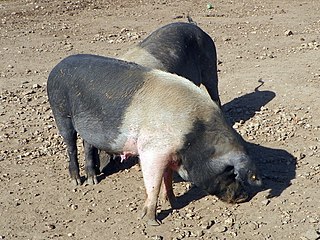
The British Saddleback is a modern British breed of domestic pig. It was created in 1967 by merging the surviving populations of two traditional saddleback breeds, the Essex and Wessex Saddleback.
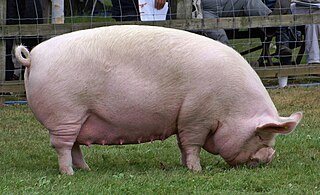
The Middle White is a British breed of domestic pig. It originated in Yorkshire, and derived from the Large White and the now-extinct Small White. It was recognised in 1852, and the first herd-book was published in 1884. It is a porker, reared for fresh pork, and is characterised by a short and sharply-upturned snout. After the Second World War it came close to extinction; although numbers have recovered somewhat, it is listed by the Rare Breeds Survival Trust as "priority" – the highest level of risk.

The Welsh is a breed of domestic pig native to Wales. It is a large white breed known for its hardiness in outdoor (extensive) farming, its long, pear-shaped body and its lop-ears. The breed was first mentioned in the 1870s, and after the Howitt committee report in 1955, became the third most common sire in the United Kingdom after the Large White pig and British Landrace pig. The Welsh pig experienced a decline in numbers in the late twentieth century because consumer demands had changed and the carcase was considered too fatty. In 2005 the breed was considered endangered and later came under the auspices of the Rare Breeds Survival Trust. Since then numbers have expanded somewhat, and by 2012, the registered breeding herd had increased to over 1000 animals.
The Yorkshire Blue and White pig, also known as the Bilsdale Blue, or as the "Blood Breed", was a breed of domestic pig originating in the United Kingdom. It is now considered extinct.

The Small White or Small Yorkshire was a British breed of domestic pig, common during the nineteenth century. It is now extinct, but its characteristics were used in producing the Middle White and other breeds.
The Cumberland was a breed of domestic pig that originated in the North of England; it was used to produce local delicacies like the Cumberland sausage and Cumberland ham. The breed became extinct in 1960, after changes in farming methods and a demand for less fatty meat led to it falling out of favour.
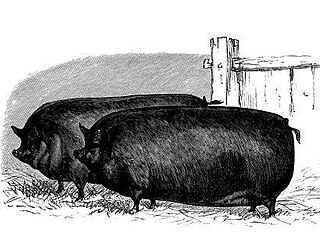
The Small Black or Suffolk pig was a breed of domestic pig originating in the United Kingdom during the nineteenth century. It is now extinct.

The British Landrace is a British domestic breed of pig and one of the most popular in the United Kingdom. It is white with heavy drooping ears that cover most of the face and is bred for pork and bacon. The breed originated in the 1949 importation of 12 landrace pigs from Scandinavia — four boars and eight gilts. In 1950, the British Landrace Pig Society was formed and it opened a herd book for the first offspring born from the imported 12. They created the first pig testing scheme with a testing station at the village of Stockton-on-the-Forest in North Yorkshire.
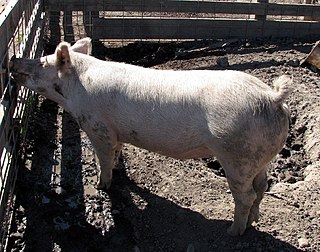
The Australian Yorkshire is a breed of domestic pig from Australia that was originally a part of the Yorkshire breed of pigs from Yorkshire, England. It is said to be the most common and popular breed of pig in Australia due to economic and nutritional advantages.
The Large White Ulster, or Ulster White, was a breed of domestic pig. Primarily bred for bacon production, it was the favoured breed of farmers in the north of Ireland up until the mid 20th century.

Krškopolje pig or Black-belted pig is an autochthonous breed of pig, originating in Slovenia. This pig represents the only still preserved Slovenian autochthonous breed of domestic pig. The easily recognizable blackish Krškopolje pig, widely used for meat production, is well known for its continuous pink belt, running across animal's shoulders and forelimbs.